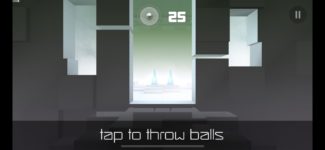Bastion
LQ: 9.15
Recommended Age: 10+
Skills Used: Planning, Working Memory, Mathematics, Reading

Smash Hit is an endless runner style game where the player has to throw balls to break glass obstacles. Along the way, the obstacles can be difficult to see. They may move back and forth across the running path or even pop out of nowhere. Some of the obstacles are big enough that they take more than one ball to break. There are also doors that have a “lock” that must be hit in order to open. If the player hits one of these obstacles, they lose three balls. It is also necessary for the player to break pyramid shaped crystals to earn more balls. Some of the crystals are partially hidden. Finally, there are also special power ups that do things like give double balls or unlimited balls.
This game has multiple single player modes, as well as two local multiplayer modes. Smash Hit also has leader boards and achievements. There are in-app purchases available. The ESRB rated it E for Everyone and LW4K stands by this rating.
Smash Hit helps kids practice and improve the following skills:
 Focus
FocusGetting started and then maintaining attention and effort to tasks.
Smash Hit gives the player the chance to practice a wide variety of focus skills. First, the player has to be able to split their focus between watching for obstacles to break and looking for crystals to break. Breaking obstacles keeps them from hitting things and losing balls; breaking crystals gives them more balls to use. The player also has to be able to focus well enough to initiate these tasks immediately. If they wait around too long, the crystals will be behind them and they will have run into the obstacles. Finally, the player will also be using their short-term focus skills (because you can only see a few obstacles at once) and will have to strengthen their long-term focus skills the longer they play.
Managing our actions, feelings, and behaviors.
This game also provides self-control practice. First, the player must think about the future. Do they have enough balls to keep playing? Is it actually worth it to try and hit that out of the way crystal? Do they need to use a ball on that moving obstacle or will it get out of the way on its own? If the player doesn't think about the future this way, they will use balls that they didn't otherwise need to use. They also need to exercise impulse control. If they throw balls as soon as they see an obstacle or crystal, they may end up missing them and use up too many trying to get it. Or, the player may end up using a ball to smash an obstacle that would have moved out of the way on its own. Finally, the player also needs to work on frustration and anger management. If they get excited and throw a bunch of balls (because of lack of impulse control) and end up missing, it is very easy to get mad about the wasted balls. But if this emotion isn't controlled, aim and impulse control will both get worse. This will result in more misses, more anger, and eventually running out of balls.
All membership plans come with full access to our entire suite of tools learning guides, and resources. Here are a few of the ones we think you’ll like the most: